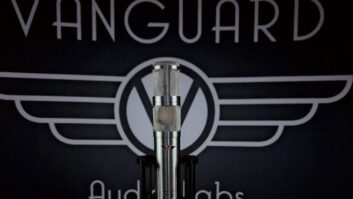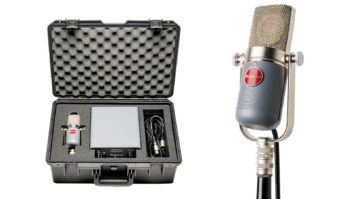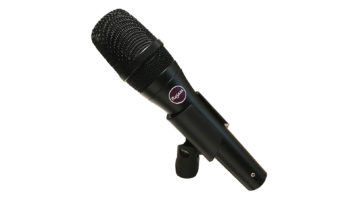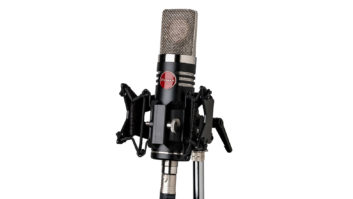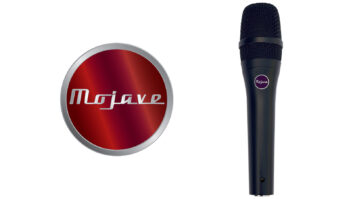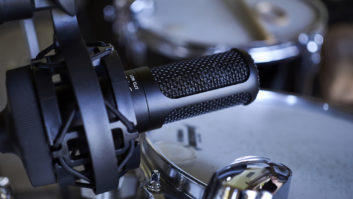
Mojave Audio, which produces a line of condenser mics from David Royer, has released its second effort. A little brother to the large-diaphragm MA-200, the MA-100 features two interchangeable, 3-micron capsules (cardioid and omni), Jensen transformer and a military-grade JAN 5840 vacuum tube. It ships in a handsome aluminum case with power supply, cable, IEC power cable and clip. The power supply can be set for either 115 volts or 230V via an external switch. Each MA-100 microphone, power supply and cable set is burned-in for 24 hours and then sent out for sale.
PERCUSSION PLUS
I first heard a pair of MA-100s used as a spaced pair of drum overheads about 1.5 feet off the top of the cymbals using the cardioid capsules. Cymbal detail was very good with no washy artifacts when hit hard. The toms and kick offered good, punchy low end and nice stick definition and beater strike. On another session with another drummer, the pair was hung over the kit in an X/Y array — again with the cardioid capsules — with comparable results. The top end provided by the pair had plenty of extended high-end detail without being in the least bit harsh; the toms and snare were well-positioned and quite up-front. All transients were slightly rounded, making for a good blend with the snare’s Shure Beta 98 direct mic, which brought more mids to the mix.
I then swung the pair over to a set of timbales placed in a spaced pair about four feet off the top of the drums. I turned off the power supply and carefully switched out the capsules to the omni pair. I had a problem with a loud hum in one of the mics, making it unusable. Unfortunately, I didn’t have time to troubleshoot this during the session, so I decided to punt and go mono with a single omni. It sounded great and was able to handle the sharp transients of the drum, yet maintained room presence. On a later session, when switching out the capsules, they operated perfectly.
The pair worked great as room mics with the omni capsules, reproducing the room sound very well and blending with the rest of the kit. The mics were set as a spaced pair 10 feet from the floor and 15 feet back from the front of the kit. This drummer had a large rock ‘n’ roll kit with cymbals the size of manhole covers. I used a pair of MA-200s as overheads about three feet from the tops of the cymbals. The combo of 100 and 200 worked very well together, providing an accurate stereo image and rendering transients that were easy on the ears. The cymbals have sounded strident in the past when recorded with less-forgiving non-tube condensers, but they sat well with the kit and were never overpowering.
I should mention that the clip that ships with the mic is very poor. The metal threaded ring that fastens it to the stand easily comes out of the rubberized clip and doesn’t inspire confidence. I also had an intermittent problem with one of the power supplies after it had operated perfectly at first. The on/off switch, which should be lit when on, would only light up when the switch was in the middle of its throw, leaving me in the dark as to whether there was power getting to the mic at all. The next day, this problem went away.
GUITAR AND ORGAN
In another session, the pair was used on either side of a wooden Leslie speaker to record a Hammond C3 organ. It brought out the honk of the horn nicely and offered plenty of balanced bottom, despite being placed at the top of the cabinet. It needed no help in the mix with EQ or compression to decisively cut through other guitars, a drum kit and an acoustic piano.
Placed about nine inches from and centered just above the soundhole on an acoustic guitar, a single MA-100 was just the ticket. It provided plenty of pick definition, tamed the normally overbearing midrange that this guitar exhibits and wasn’t boomy in the least. If anything, it needed a bit of dressing up for the mix with some 100 Hz added, but that’s because the recording would support it, not because the MA-100 was lacking.
PROBLEM-SOLVER
In spite of the intermittent ghosts that visited twice during my time with the mics and the poorly designed clip, the MA-100s operated flawlessly. The great thing about this mic is that its forgiving transient response and silky top end seem to fix a variety of problems I’ve had in the studio with certain instruments when using condensers with a faster transient response.
I’m reluctant to say they’re inaccurate because that sounds negative; I’d describe it better as a mic with an altered personality that is flattering to certain instruments with brash qualities. It tamed an oft-encountered acoustic guitar that has an overbearing upper-midrange and balanced a big rock drum kit with large cymbals that likes to tear your face off. In these situations, and in others when recording instruments with better aural behavior, the mics operated like journeymen transducers, delivering a well-defined stereo image, frequency range and transient response. Having a mic this versatile come with two capsules for less than $1k ($795) is a steal. Mojave’s second outing is a must-hear.
Mojave Audio, 818/847-0222,
www.mojaveaudio.com.
